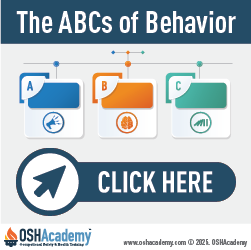The ABCs of Behavior
To better understand what drives the behaviors of students we teach, let's look at some basic behavioral-based safety (BBS) concepts.
These concepts explain why we do what we do in the workplace. The ABCs of safety behavior are: Activators; Behaviors; and Consequences.
Activators
Activators and things we say, do, feel, think, hear, and see that tend to activate a behavior in ourselves or others. They are also called "antecedents" because they come before the resulting behaviors. Either way, you get the idea. Examples of activators at work might include:
- Hearing something said in a safety training session
- Seeing a co-worker get hurt
- Being reprimanded for violating a safety rule
The above activators may cause internal thoughts, beliefs, and feelings such as:
- "Hey, this committee is doing great things"
- "Wow, I need to be careful on this job"
- "I better not violate this safety rule again"
Behaviors
Safety behaviors occur in response to activators. We usually choose to do things for a reason, don't we? Here are some examples of safety-related behaviors:
- I keep coming to safety committee meetings
- I warn others about the hazards of a job
- I will use safe practices from now on
Consequences
Behaviors are primarily based on what we believe the consequences will be. We quickly weigh the perceived positive consequences against the negative consequences, and react accordingly. Consequences, both natural (automatic) and systemic (from the organization), always follow behaviors. For more on consequences, see course 712 Safety Supervision and Leadership.
Below are some examples of consequences that you might experience.
- You get a pay raise for being an active member of the safety committee
- You and your coworkers don't get hurt on the job
- You are recognized by others for being safe
These consequences, in turn, become activators that increase or decrease the likelihood of future behaviors.
Now that we have a pretty good understanding of the ABCs of behavior, we can devise some strategies that will act as activators influencing behaviors during the training session. Let's look at a few of these strategies.
Knowledge Check Choose the best answer for the question.
5-3. Which of the following are the elements of the ABCs of behavior?
You forgot to answer the question!

